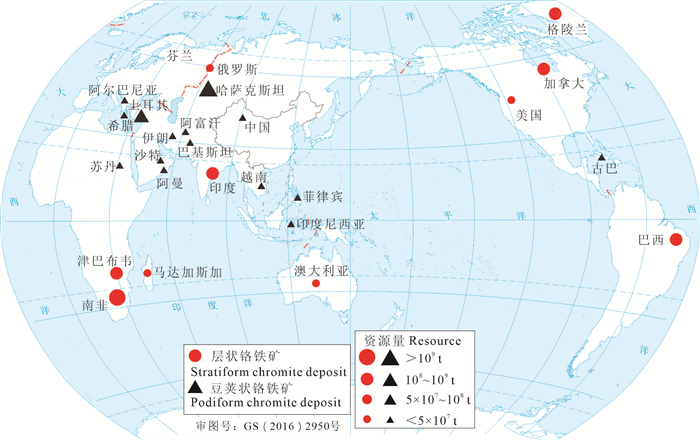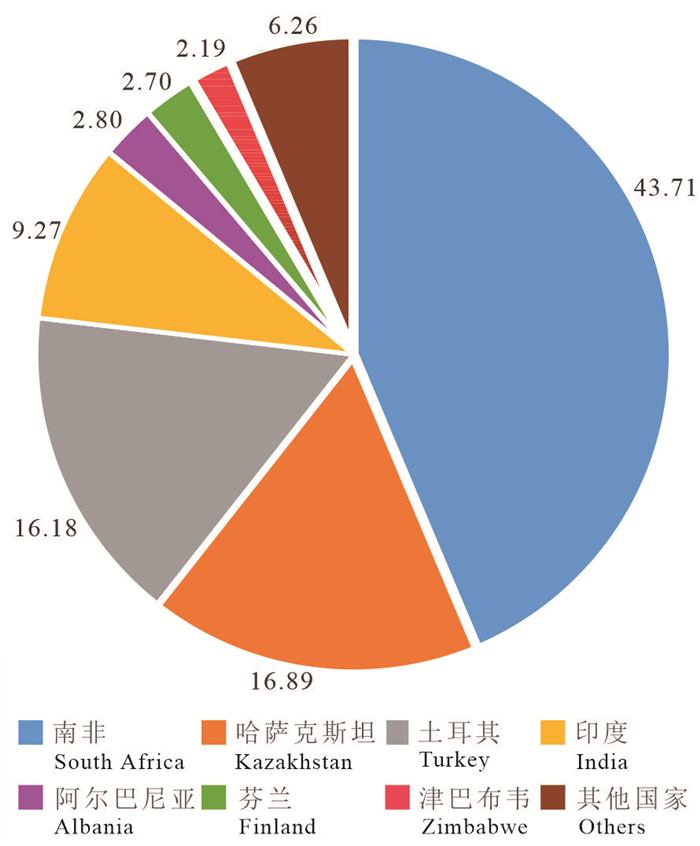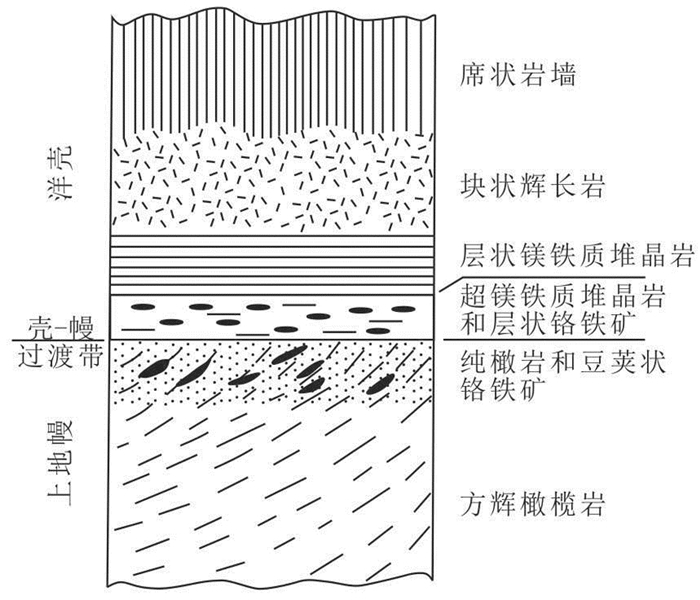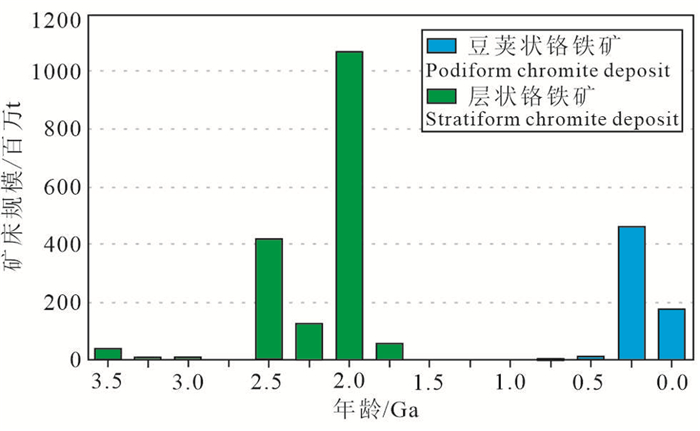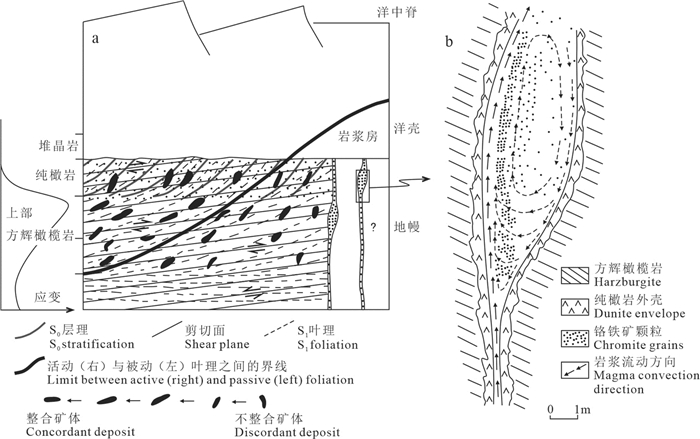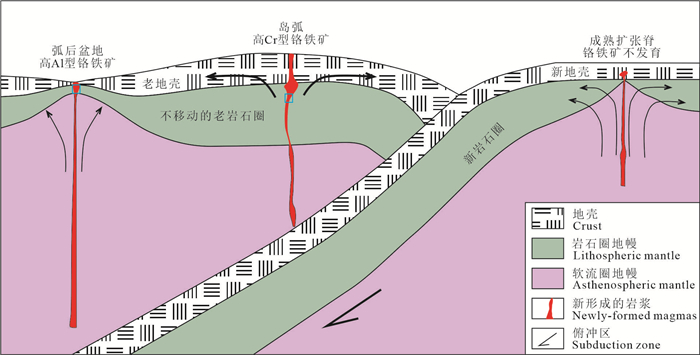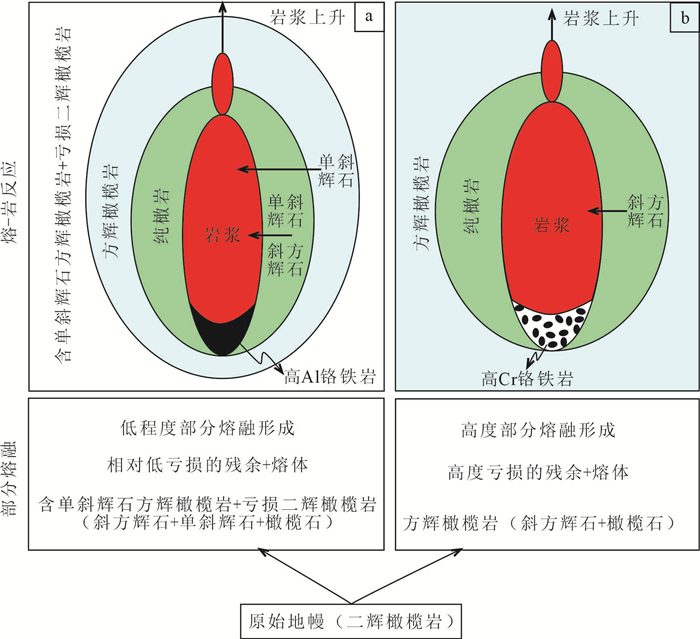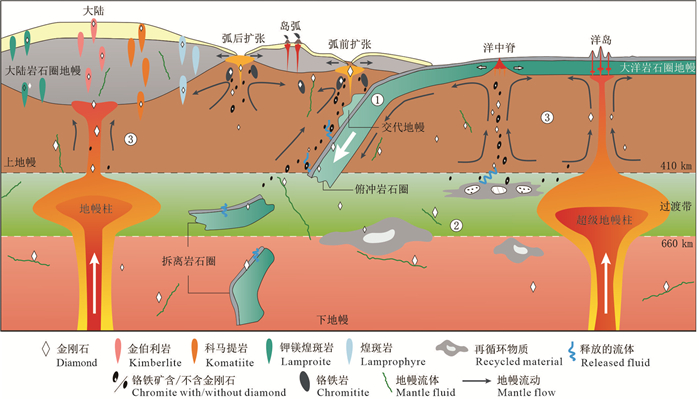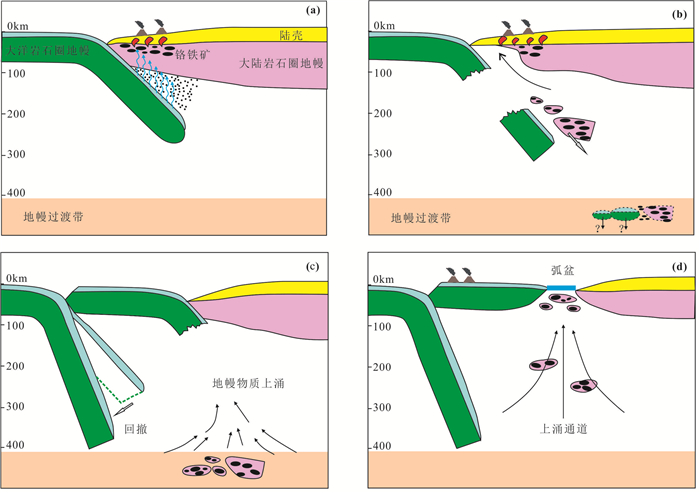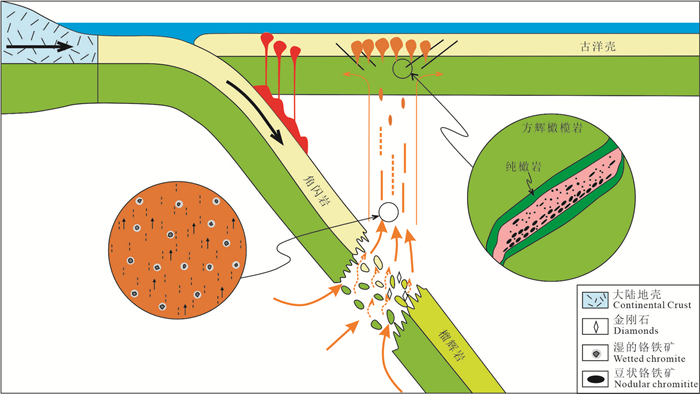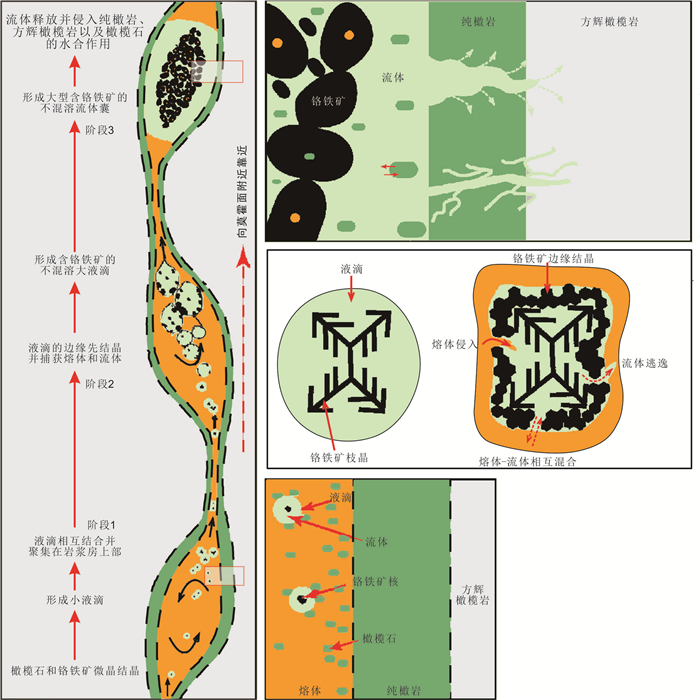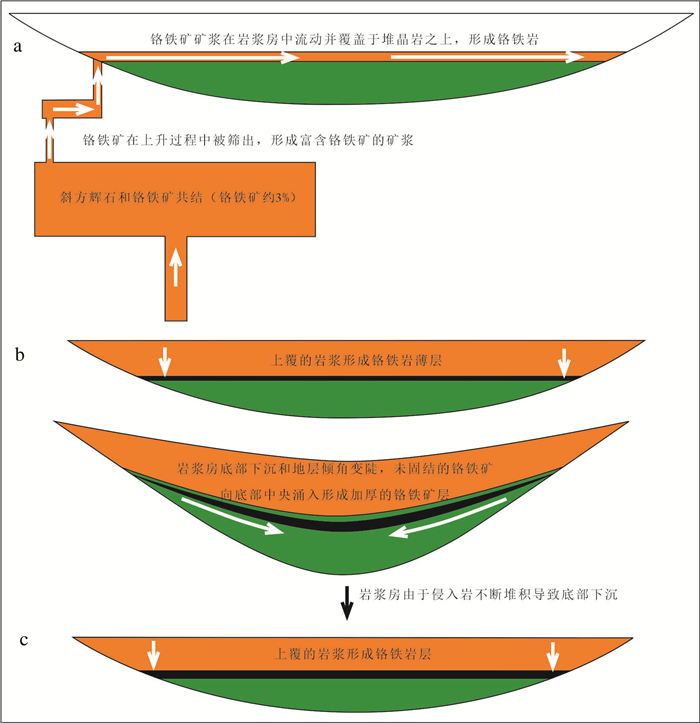-
摘要:研究目的
铬铁矿的形成与基性—超基性岩有关,对于铬铁矿的成因机制存在诸多争议,深化铬铁矿的成因研究对于实现铬铁矿找矿突破具有重要意义。
研究方法通过对前人研究成果的梳理,总结了铬铁矿的成矿类型、成矿时代、矿体特征和成因研究进展。
研究结果铬铁矿资源和产量高度集中,南非、哈萨克斯坦、芬兰和印度4国的铬铁矿储量占全球的95%以上,南非、哈萨克斯坦和土耳其等国主宰了世界铬铁矿的供应市场。铬铁矿类型主要有原生铬铁矿和次生铬铁矿两大类,原生铬铁矿主要是层状和豆荚状2种类型,次生铬铁矿主要是铬铁矿海滨(或海成)砂矿。层状铬铁矿通常形成于稳定克拉通内部的基性—超基性侵入体内,通常规模巨大。豆荚状铬铁矿与蛇绿岩密切共生,分布最为广泛,但矿床规模普遍较小,其产状、结构构造和共生矿物组合等存在较大差异。豆荚状铬铁矿主要形成于显生宙,少量形成于中—新元古代,层状铬铁矿主要形成于元古代,集中于古元古代。
结论对于层状铬铁矿成因模式争议较小,主要有同化混染硅铝质围岩和岩浆混合两种模式;而豆荚状铬铁矿的成因模式较多,尚未达成共识,未来应重点聚焦铬的富集机制研究。
创新点:全面系统地梳理了豆荚状铬铁矿和层状铬铁矿的成矿类型、成矿时代、矿体特征和成因研究进展;关于豆荚状铬铁矿中铬的富集机制有待更深入的研究。
Abstract:This paper is the result of mineral exploration engineering.
ObjectiveThe formation of chromite is generally related to basic-ultrabasic rocks. However, the genetic mechanism of chromite deposit remains controversial. Deciphering the genesis of chromite deposit is of great significance for ore exploration.
MethodsThis review work summarizes the ore types, metallogenic age, ore body characteristics and genetic mechanisms of chromite based on previous research results. New perspectives are also provided.
ResultsThe chromite resources and production are highly concentrated at South Africa, Kazakhstan, Finland and India, accounting for more than 95% of the global chromite reserves. The global chromite supply market is dominated by South Africa, Kazakhstan and Turkey. There are two major chromite types, namely primary and secondary chromite. Primary chromite is mainly stratiform and podiform, while secondary chromite is mainly seashore placer chromite (or marine placer chromite). The stratiform chromite deposit is commonly huge in scale and formed associated with the basic-ultrabasic intrusions within stable cratons. The podiform chromite deposit is widely distributed and closely symbiotic with ophiolite, but the scale of this deposit is generally small. There are obvious differences in the occurrence, fabric, structure and paragenetic association of the two different chromite types. The podiform chromite is mainly formed in the Phanerozoic, with a small amount formed in the Meso-Neoproterozoic. The stratiform chromite is mainly formed in the Proterozoic and concentrated in the Paleoproterozoic.
ConclusionsThe genetic model of the stratiform chromite deposit is less controversial, mainly focusing on the contamination mechanism of salic roof rocks and the magma mixture. In contrast, little consensus has been reached on the genetic models of podiform chromite. The enrichment mechanism of chromium is a key issue for more scientific constraints in the future.
-
Keywords:
- chromite /
- genetic type /
- metallogenic age /
- genetic model /
- research progress /
- mineral exploration engineering
-
1. 研究目的(Objective)
湘中坳陷作为南方复杂构造区页岩气勘探的热点地区之一,也是中国油气勘探久攻未克的地区。前期在湘中地区北部的涟源凹陷泥盆系和石炭系获得了页岩气突破和发现,证实了湘中地区上古生界页岩气资源丰富。但对湘中地区南部的邵阳凹陷调查程度较为薄弱,针对邵阳凹陷二叠系仅开展了少量基础地质调查工作,页岩气资源潜力评价方面的工作尤为欠缺。本次研究依托邵阳湘邵地1井(XSD1井)钻探工程建立了邵阳凹陷二叠系地层层序序列,揭示了主要含气页岩层系的分布特征,获取了含气性评价参数,对湘中地区二叠系页岩气勘探开发和重新评价湘中坳陷页岩气资源潜力具有重要的现实意义。
2. 研究方法(Methods)
中国地质调查局武汉地质调查中心在收集分析区域地质相关资料的基础上,结合邵阳凹陷短陂桥向斜的煤田浅钻、非震物探等资料开展页岩气地质综合评价,采用页岩埋深500~4500 m,页岩有机碳含量≥1.0%,页岩厚度≥15 m,页岩有机质热演化程度1.0%~3.5%的评价参数在短陂桥向斜区优选页岩气远景区,论证部署了1口小口径页岩气地质调查井—XSD1井,湖南煤田地质勘查有限公司组织实施钻探(图 1a)。该井采样全井段取心钻井工艺,测井选取PSJ-2数字测井系统,录井采用SK-2000G气测录井,钻获二叠系大隆组156.05 m(暗色硅质页岩、钙质泥岩94.48 m),龙潭组349.95 m(暗色泥岩216.93 m,粉砂质泥岩36.9 m),对这两套层系共采集暗色泥岩样品33件,进行解析气含量测定分析,落实了含气性评价参数。
3. 结果(Results)
本次样品分析工作由武汉地质调查中心古生物与生命-环境协同演化重点实验室完成,采用YSQ-IIIA岩石解析气测定仪(燃烧法)对含气段岩心共计33件样品进行分析。该井钻获二叠系大隆组厚度156.05 m,为一套硅质岩、硅质页岩、炭质钙质泥岩地层。其中在井深842~930.2 m硅质页岩、钙质泥岩段,气测全烃值从1.06%上升至16.54%,甲烷值从1.01%上升至14.04%,13件大隆组硅质页岩现场解析总含气量为1.29~9.97 m3/t,平均4.85 m3/t。实现了湘中坳陷二叠系页岩气新发现,有效拓展了华南地区大隆组勘探范围。
钻获龙潭组厚度349.95 m,上段为一套细砂岩、粉砂岩夹泥岩潮坪相沉积地层,下段为一套炭质泥岩、粉砂质泥岩夹薄层细砂岩泻湖相沉积地层。在井深1013.4~1048 m泥岩与粉砂岩互层段气测全烃值最高可达19.87%,甲烷值最高为16.94%,7件泥岩与粉砂岩样品现场解析总含气量0.57~3.42 m3/t,平均1.78 m3/t;井深1088.10~1199.75 m泥岩夹泥质粉砂岩含气层111.6 m,气测全烃值最高可达28.2%,甲烷值最高为23.6%,13件泥岩、粉砂质泥岩样品现场解析总含气量0.90~4.55 m3/t,平均2.01 m3/t(图 1b),首次查明了湘中坳陷二叠系龙潭组非常规油气分布特点。
通过区域地质背景分析,并结合煤田区域地质资料,本研究认为滑脱断裂(F9)上下盘具有不同的页岩气聚集条件。滑脱断裂之上由一系列的同向逆断层形成的逆冲推覆体,地层变形强烈,且裂缝发育,导致页岩气保存条件变差。滑脱断裂下盘是页岩气主要富集区,地层平缓,不发育次级通天断裂,与下盘地层形成反向遮挡,易形成封闭,保存条件良好(图 1c)。
4. 结论(Conclusions)
(1)二叠系大隆组岩性以硅质岩、硅质页岩为主,夹少量灰岩。主要含气段存在于上段硅质页岩段,厚88.2 m,含气量平均为4.85 m3/t,含气性优越,资源潜力大。
(2)二叠系龙潭组上段以致密砂岩气为主,含气量平均为1.78 m3/t;下段以页岩气为主,泥岩厚达177.47 m,含气量平均为2.01 m3/t,具有泥岩厚度大,含气性好等特征。
(3)保存条件是页岩气富集关键,构造改造弱的封闭演化环境有利于页岩气保存,研究区滑脱断裂下盘是页岩气主要富集区,易形成封闭,保存条件良好。
(4)湘邵地1井在二叠系大隆组和龙潭组获得良好的页岩气显示,证实了湘中地区二叠系具有良好的页岩气资源潜力,对湘中地区页岩气资源潜力评价具有重要意义。
5. 基金项目(Fund support)
本文为中国地质调查局项目“中扬子地区油气页岩气调查评价”(DD20221659)资助的成果。
致谢: 审稿专家和责任编辑提出了宝贵和建设性的修改意见,在此谨致谢忱。 -
图 1 全球铬铁矿资源分布与矿床类型(据Koleli and Demir, 2016修改)
Figure 1. Distribution and types of global chromite resoures (modified from Koleli and Demir, 2016)
图 3 想蛇绿岩套剖面中铬铁矿的产出部位(据Paktunc, 1990修改)
Figure 3. The setting of chromite of an idealized ophiolite section (modified from Paktunc, 1990)
图 4 蛇绿岩豆荚状、层状铬铁矿时代分布(据Stowe, 1994)
Figure 4. Time distribution of ophiolitic podiform and stratiform chromite ore deposit (after Stowe, 1994)
图 5 在活动扩张脊下部的洋壳地幔最上部地幔中豆荚状铬铁矿的成因与演化(a);方辉橄榄岩中发育玄武质似墙状的岩浆通道,豆荚状铬铁矿在通道的“洞穴”内形成(b)(据Lago et al., 1982修改)
Figure 5. Genesis of the podiform chromite in uppermost oceanic mantle beneath an active spreading ridge (a); Podiform chromite formed inside a cavity along magma channel in the harzburgite (b) (modified from Lago et al., 1982)
图 6 铬铁矿的熔-岩反应形成与构造背景关系简图(据Zhou and Robinson, 1997修改)
Figure 6. Relationship between the formation of podiform chromitites and tectonic setting (modified from Zhou and Robinson, 1997)
图 7 高Cr和高Al铬铁岩的熔-岩反应模式(据Zhou et al., 1994修改)
Figure 7. A melt-rock interaction model for the formation of both high-Cr and high-Al chromitites (modified from Zhou et al., 1994)
图 8 豆荚状铬铁矿形成的地幔柱模式(据Yang et al., 2021修改)
Figure 8. Mantle plume model for the formation of podiform chromitites (modified from Yang et al., 2021)
图 9 豆荚状铬铁矿形成的板片回撤模式图(据Griffin et al., 2016修改)
Figure 9. Slab rollback model for the formation of podiform chromitites (modified from Griffin et al., 2016)
图 10 豆荚状铬铁矿形成的板片断离模式图(据Zhou et al., 2014修改)
Figure 10. Slab breakoff model for the formation of podiform chromitites (modified from Zhou et al., 2014)
图 11 豆荚状铬铁矿形成的流体不混溶模式图(据苏本勋等,2021修改)
Figure 11. Fluid immiscibility model for the formation of podiform chromitites (modified from Su Benxun et al., 2021)
图 12 层状铬铁矿形成模式图(据Naldrett et al., 2012修改)
a, b—异位模式;c—原位模式
Figure 12. Formation of stratiform chromitites (modified from Naldrett et al., 2012)
a, b-Offstage models; c-Onstage models
表 1 世界铬铁矿主要资源国铬铁矿储量
Table 1 Chromite reserves in major chromite resource countries in the world

表 2 世界铬铁矿主要资源国铬铁矿产量统计(万t)
Table 2 Chromite production in main chromite resource countries in the world (Ten thousand tons)

-
Arai S. 2013. Conversion of low-pressure chromitites to ultrahigh-pressure chromitites by deep recycling: A good inference[J]. Earth and Planetary Science Letters, 379: 81-87. doi: 10.1016/j.epsl.2013.08.006
Arai S, Yurimoto H, 1994. Podiform chromitites of the Tari-Misaka ultramafic complex, southwestern Japan, as mantle-melt interaction products[J]. Economic Geology, 89(6): 1279-1288. doi: 10.2113/gsecongeo.89.6.1279
Bao Peisheng. 2019. Proterozoic ophiolite and chromite[J]. Acta Petrologica Sinia, 35(10): 2971-2988 (in Chinese with English abstract). doi: 10.18654/1000-0569/2019.10.03
Bao Peisheng, Wang Xibin. 1999. Chinese Chromite[M]. Beijing: Science Press (in Chinese).
Bao Peisheng, Wang Xibin, Hao Zhiguo, Peng Genyong, Zhang Rangmin, Chen Qingzhi, Yang Tinghui. 1990. A new idea about the genesis of the aluminum-rich podiform chromite deposit——with the Sartuohai chromite deposit of Xinjiang as an example[J]. Mineral Deposits, 9(2): 97-111 (in Chinese with English abstract).
Chen Yanhong, Yang Jingsui. 2017. Formation of podiform chromitite deposits: Review and prospects[J]. Earth Science, 43(4): 991-1010 (in Chinese with English abstract).
Das S, Basu A R, Mukherjee B K, 2017. In situ peridotitic diamond in Indus ophiolite sourced from hydrocarbon fluids in the mantle transition zone[J]. Geology, 45: 755-758.
Eales H V, 2000. Implications of the chromium budget of the Western Limb of the Bushveld Complex[J]. South African Journal of Geology, 103(2): 141-150. doi: 10.2113/103.2.141
Fisher. 1929. Origin of chromite deposits[J]. Economic Geology, 24: 691-721. doi: 10.2113/gsecongeo.24.7.691
Gong Xuejing, Zhang Tengjiao, Xiao Rongge. 2013. Research status and progress on the genesis of podiform chromite deposits in China[J]. Geological Journal of China Universities, 19(S): 275-276 (in Chinese with English abstract).
Griffin W L, Afonso J C, Belousova E A, Gain S E, Gong X H, González-Jiménez J M, Howell D, Huang J X, McGowan N, Pearson N J, Satsukawa T, Shi R, Williams P, Xiong Q, Yang J S, Zhang M, O Reilly S Y. 2016. Mantle recycling: Transition zone metamorphism of Tibetan ophiolitic peridotites and its tectonic implications[J]. Journal of Petrology, 57(4): 655-684. doi: 10.1093/petrology/egw011
Gujar A R, Ambre N V, Iyer S D, Mislankar P G, Loveson V J. 2010a. Placer chromite along south Maharashtra, central west coast of India[J]. Current Science (Bangalore), 99(4): 492-499.
Gujar A R, Ambre N V, Mislankar P G, Iyer S D. 2010b. Ilmenite, magnetite and chromite beach placers from South Maharashtra, central west coast of India[J]. Resource Geology, 60(1): 71-86. doi: 10.1111/j.1751-3928.2010.00115.x
Guo Jia, Yi Jining, Wang Hui. 2018. Comparative study on evaluation factors of global major strategic mineral lists[J]. Modern Mining, 596(12): 1-5 (in Chinese).
Hamdy M M, Lebda E M. 2011. Al-compositional variation in ophiolitic chromitites from the south Eastern Desert of Egypt: Petrogenetic implications[J]. Journal of Geology and Mining Research, 3(9): 232-250.
Hao Zhiguo. 1989. Review of the podiform chromitite deposits[J]. Geology and Geochemistry, (3): 15-20 (in Chinese).
Howell D, Griffin W L, Yang J, Gain S, Stern R A, Huang J X, Jacob D E, Xu X, Stokes A J, O'Reilly S Y, Pearson N J. 2015. Diamonds in ophiolites: Contamination or a new diamond growth environment?[J]. Earth and Planetary Science Letters, 430: 284-295. doi: 10.1016/j.epsl.2015.08.023
Hu Zhenxing, Niu Yaoling, Liu Yi, Zhang Guorui, Sun Wenli, Ma Yuxin. 2014. Petrogenesis of ophiolite-type chromite deposits in China and some new perspectives[J]. Geological Journal of China Universities, 20(1): 9-27 (in Chinese with English abstract).
Huang Yang, Deng Hao. 2020. FIB-TEM study of mineral inclusions in chromite[J]. Earth Science, 45(12): 4604-4616 (in Chinese with English abstract).
Irvine T N. 1975. Crystallization sequences in the Muskox intrusion and other layered intrusions——Ⅱ. Origin of chromitite layers and similar deposits of other magmatic ores[J]. Geochimica et Cosmochimica Acta, 39: 991-1020. doi: 10.1016/0016-7037(75)90043-5
Irvine T N, 1977. Origin of chromitite layers in the Muskox intrusion and other stratiform intrusions: A new interpretation[J]. Geology, 5: 273-277.
Johnson P R, Andresen A, Collins A S, Fowler A R, Fritz H, Ghebreab W, Kusky T, Stern R J. 2011. Late Cryogenian-Ediacaran history of the Arabian-Nubian Shield: A review of depositional, plutonic, structural, and tectonic events in the closing stages of the northern East African Orogen[J]. Journal of African Earth Sciences, 61(3): 167-232. doi: 10.1016/j.jafrearsci.2011.07.003
Koleli N, Demir A. 2016. Chromite (Chapter 11)[M]. Resource Recovery and Pollution Prevention: 245-263.
Kontinen A. 1987. An early Proterozoic ophiolite: The Jormua mafic-ultramafic complex, Northeastern Finland[J]. Precambrian Research, 35: 313-341. doi: 10.1016/0301-9268(87)90061-1
Lago B L, Michel R, Adolphe N. 1982. Podiform chromite ore bodies: A genetic model[J]. Journal of Petrology, 23: 103-125. doi: 10.1093/petrology/23.1.103
Liu Ting, Zheng Youye, Wu Jun. 2021. Genesis of Fuchuan chromitites at South Anhui, implications from the parental melts[J]. Earth Science, 46(5): 1613-1629 (in Chinese with English abstract).
MacLeod C J, Lissenberg C J, Bibby L E. 2013. "Moist MORB" axial magmatism in the Oman ophiolite: The evidence against a mid-ocean ridge origin[J]. Geology, 41(4): 459-462. doi: 10.1130/G33904.1
Matveev S, Ballhaus C. 2002. Role of water in the origin of podiform chromitite deposits[J]. Earth and Planetary Science Letters, 203(1): 235-243. doi: 10.1016/S0012-821X(02)00860-9
McGowan N M, Griffin W L, González-Jiménez J M, Belousova E, Afonso J C, Shi R D, McCammon C A, Pearson N J, O'Reilly S Y. 2015. Tibetan chromitites: Excavating the slab graveyard[J]. Geology, 43(2): 179-182. doi: 10.1130/G36245.1
Mondal S K, Mathez E A. 2007. Origin of the UG2 chromitite layer, Bushveld Complex[J]. Journal of Petrology, 48(3): 495-510. doi: 10.1093/petrology/egl069
Mukasa S B, Wilson A H, Carlson R W. 1998. A multielement geochronologic study of the Great Dyke, Zimbabwe: Significance of the robust and reset ages[J]. Earth and Planetary Science Letters, 164(1/2): 353-369.
Naldrett A J, Wilson A, Kinnaird J, Yudovskaya M, Chunnett G. 2012. The origin of chromitites and related PGE mineralization in the Bushveld Complex: New mineralogical and petrological constraints[J]. Mineralium Deposita, 47(3): 209-232. doi: 10.1007/s00126-011-0366-3
Paktunc A D. 1990. Origin of podiform chromite deposits by multistage melting, melt segregation and magma mixing in the upper mantle[J]. Ore Geology Reviews, 5: 211-222. doi: 10.1016/0169-1368(90)90011-B
Parrish R R. 1989. U-Pb geochronology of the Cape Smith Belt and Sugluk block, northern Quebec[J]. Geoscience Canda, 16(3): 126-130.
Patchett J P, Kouvo O, Hedge C E, Tatsumoto M. 1981. Evolution of continental crust and mantle heterogeneity: Evidence from Hf isotopes[J]. Contributions to Mineralogy and Petrology, 78: 279-297.
Ruskov T, Spirov I, Georgieva M, Yamamoto S, Green H W, McCammon C A, Dobrzhinetskaya L F. 2010. Mossbauer spectroscopy studies of the valence state of iron in chromite from the Luobusa massif of Tibet: Implications for a highly reduced deep mantle[J]. Journal of Metamorphic Geology, 28(5): 551-560. doi: 10.1111/j.1525-1314.2010.00878.x
Satsukawa T, Griffin W L, Piazolo S, O Reilly S Y. 2015. Messengers from the deep: Fossil wadsleyite-chromite microstructures from the mantle transition zone[J]. Scientific Reports, 5(1): 16484. doi: 10.1038/srep16484
Schoenberg R, Kruger F J, Nagler, T F, Meisel T, Kramers J D. 1999. PGE enrichment in chromitite layers and the Merensky Reef of the western Bushveld Complex: A Re-Os and Rb-Sr isotope study[J]. Earth and Planetary Science Letters, 172(1): 49-64.
Schulz K J, Deyoung J H, Seal R R, Bradley D C. 2017. Critical mineral resources of the United States: Economic and environmental geology and prospects for future supply[J]. U.S. Geological Survey Professional Paper, 1802: 1-797.
Spandler C, Mavrogenes J, Arculus R. 2005. Origin of chromitites in layered intrusions: Evidence from chromite-hosted melt inclusions from the Stillwater Complex[J]. Geology, 33(11): 893-896. doi: 10.1130/G21912.1
Stern R J, Johnson P R, Kroner A, Yibas B. 2004. Neoproterozoic ophiolites of the Arabian-Nubian Shield[J]. Developments in Precambrian Geology, 13: 95-128.
Stowe C W. 1994. Compositions and tectonic settings of chromite deposits through time[J]. Economic Geology, 89: 528-546. doi: 10.2113/gsecongeo.89.3.528
Su B X, Robinson P T, Chen C, Xiao Y, Melcher F, Bai Y, Gu X Y, Uysal I, Lenaz D. 2020. The occurrence, origin, and fate of water in chromitites in ophiolites[J]. American Mineralogist, 105(6): 894-903. doi: 10.2138/am-2020-7270
Su B, Liu X, Chen C, Robinson P T, Xiao Y, Zhou M, Bai Y, Uysal I, Zhang P. 2021. A new model for chromitite formation in ophiolites: Fluid immiscibility[J]. Science China (Earth Sciences), 64(2): 220-230. doi: 10.1007/s11430-020-9690-4
Teng Fei, Meng Qinglong, Xing Yi. 2021. Study on the distribution laws of the iron deposits and the features of gravity-magnetic field in the southern margin of the North China Craton[J]. Geological Survey and Research, 44(3): 71-76 (in Chinese with English abstract).
Thayer T P. 1960. Some critical differences between alpine-type and stratiform peridotite-gabbro complexes[J]. 21st International Geological Congress Copenhagen, 13: 247-259.
Uysal I, Akmaz R M, Kapsiotis A, Demir Y, Saka S, Avci E, Müller D. 2015. Genesis and geodynamic significance of chromitites from the Orhaneli and Harmancik ophiolites (Bursa, NW Turkey) as evidenced by mineralogical and compositional data[J]. Ore Geology Reviews, 65: 26-41. doi: 10.1016/j.oregeorev.2014.08.006
Vuollo J, Liipo J, Nykanen V, Piirainen T, Pekkarinen L, Tuokko I, Ekdahl E. 1995. An early Proterozoic podiform chromitite in the Outokumpu ophiolite complex, Finland[J]. Economic Geology, 90(2): 445-452. doi: 10.2113/gsecongeo.90.2.445
Wang Christina Yan, Zhong Hong, Cao Yonghua, Wei Bo, Chen Chen. 2020. Genetic classification, distribution and ore genesis of major PGE, Co and Cr deposits in China: A critical review[J]. Chinese Science Bulletin, 65: 3825-3838 (in Chinese with English abstract). doi: 10.1360/TB-2020-0202
Wang Xibin, Bao Peisheng. 1987. The genesis of podiform chromite deposits: A case study of the Luobosa chromite deposit, Tibet[J]. Acta Geologica Sinica, (2): 166-181 (in Chinese with English abstract).
Whattam S A, Stern R J. 2011. The 'subduction initiation rule': A key for linking ophiolites, intra-oceanic forearcs, and subduction initiation[J]. Contributions to Mineralogy and Petrology, 162(5): 1031-1045. doi: 10.1007/s00410-011-0638-z
Xiong F H, Yang J S, Robinson P T, Xu X Z, Liu Z, Li Y, Li J Y, Chen S Y. 2015. Origin of podiform chromitite: A new model based on the Luobusa ophiolite, Tibet[J]. Gondwana Research, 27(2): 525-542. doi: 10.1016/j.gr.2014.04.008
Yamamoto S, Komiya T, Hirose K, Maruyama S. 2009. Coesite and clinopyroxene exsolution lamellae in chromites: In-situ ultrahigh-pressure evidence from podiform chromitites in the Luobusa ophiolite, southern Tibet[J]. Lithos, 109(3/4): 314-322.
Yang J S, Meng F C, Xu X Z, Robinson P T, Dilek Y, Makeyev A B, Wirth R, Wiedenbeck M, Cliff J. 2015. Diamonds, native elements and metal alloys from chromitites of the Ray-Iz ophiolite of the Polar Urals[J]. Gondwana Research, 27(2): 459-485. doi: 10.1016/j.gr.2014.07.004
Yang J S, Wu W W, Lian D Y, Rui H C. 2021. Peridotites, chromitites and diamonds in ophiolites[J]. Nature Reviews Earth and Environment, 2(3): 198-212. doi: 10.1038/s43017-020-00138-4
Yang Yiheng, Zeng Le, Deng Fan, Hu Jianzhong. 2018. Geological characteristics and mineralization potential of chromite resources in China[J]. Earth Science Frontiers, 138-147 (in Chinese with English abstract).
Zhang Baosong, Di Bingye, Huang Ning, Zhu Hongbing, Chen Jiwei, Zhang Jun. 2021 Characteristics of geophysical field and delineation of volcanic structures in Lishui volcanic basin area[J]. Geological Survey and Research, 44(1): 39-44 (in Chinese with English abstract).
Zhang Weibo, Liu Yifei, Wang Fengxiang, Chen Xiufa, He Xuezhou, Yu Rui. 2020. New progress of the research on the Kemi chromitite deposit in Finland[J]. Geological Bulletin of China, 39(5): 746-754 (in Chinese with English abstract).
Zhao Yage, Zhang Yanfei, Wang Chao, Jin Zhenmin, Xu Qijin. 2020. Experimental constraints on formation of low-Cr# chromitite: effect of variable H2O and Cr2O3 on boninitic-magma and harzburgite reactions[J]. Journal of Earth Science, 31: 709-722. doi: 10.1007/s12583-020-1291-0
Zhou Erbin. 2011. Present situation and advances in the study of podiform chromite deposits[J]. Acta Petrologica et Mineralogica, 30(3): 530-542 (in Chinese with English abstract).
Zhou M F, Robinson P T. 1994. High-Cr and high-Al podiform chromitites, western China: Relationship to partial melting and melt/rock reaction in the upper mantle[J]. International Geology Review, 36(7): 678-686. doi: 10.1080/00206819409465481
Zhou M F, Robinson P T. 1997. Origin and tectonic environment of podiform chromite deposits[J]. Economic Geology, 92: 259-262. doi: 10.2113/gsecongeo.92.2.259
Zhou M F, Robinson P T, Bail W J. 1994. Formation of podiform chromitites by melt/rock interaction[J]. Mineral Deposita, 29: 98-101. doi: 10.1007/BF03326400
Zhou M F, Robinson P T, Su B X, Gao J F, Li J W, Yang J S, Malpas J. 2014. Compositions of chromite, associated minerals, and parental magmas of podiform chromite deposits: The role of slab contamination of asthenospheric melts in suprasubduction zone environments[J]. Gondwana Research, 26(1): 262-283. doi: 10.1016/j.gr.2013.12.011
鲍佩声. 2019. 元古代蛇绿岩及铬铁矿[J]. 岩石学报, 35(10): 2971-2988. doi: 10.18654/1000-0569/2019.10.03 鲍佩声, 王希斌. 1999. 中国铬铁矿[M]. 北京: 科技出版社. 鲍佩声, 王希斌, 郝梓国, 彭根永, 张让民, 陈清植, 杨廷辉. 1990. 对富铝型豆荚状铬铁矿矿床成因的新认识——以新疆萨尔托海铬铁矿矿床为例[J]. 矿床地质, 9(2): 97-111. https://www.cnki.com.cn/Article/CJFDTOTAL-KCDZ199002000.htm 陈艳虹, 杨经绥. 2018. 豆荚状铬铁矿床研究回顾与展望[J]. 地球科学, 43(4): 991-1010. https://www.cnki.com.cn/Article/CJFDTOTAL-DQKX201804005.htm 龚雪婧, 张腾蛟, 肖荣阁. 2013. 中国豆荚状铬铁矿床成因的研究现状及进展[J]. 高校地质学报, 19(S): 275-276. https://cpfd.cnki.com.cn/Article/CPFDTOTAL-ZGKD201304001269.htm 郭佳, 易继宁, 王慧. 2018. 全球主要战略性矿产名录评价因素对比研究[J]. 现代矿业, 34(12): 1-5. 郝梓国. 1989. 豆荚型铬铁矿床的研究现状[J]. 地质地球化学, (3): 15-20. 胡振兴, 牛耀龄, 刘益, 张国瑞, 孙文礼, 马玉鑫. 2014. 中国蛇绿岩型铬铁矿的研究进展及思考[J]. 高校地质学报, 20(1): 9-27. 黄阳, 邓浩. 2020. 铬铁矿矿物包裹体的聚焦离子束-透射电镜研究[J]. 地球科学, 45(12): 4604-4616. 刘婷, 郑有业, 武珺. 2021. 皖南蛇绿岩伏川铬铁矿床成因: 铬铁矿母岩浆证据[J]. 地球科学, 46(5): 1613-1629. https://www.cnki.com.cn/Article/CJFDTOTAL-DQKX202105006.htm 苏本勋, 刘霞, 陈晨, Robinson P T, 肖燕, 周美夫, 白洋, Uysal I, 张鹏飞. 2021. 蛇绿岩铬铁矿成矿新模型流体不混溶作用[J]. 中国科学: 地球科学, 51(2): 250-260. https://www.cnki.com.cn/Article/CJFDTOTAL-JDXK202102006.htm 滕菲, 孟庆龙, 邢怡. 2021. 从重磁场特征分析华北陆块南缘铁矿分布规律[J]. 华北地质, 44(3): 70-76. 王希斌, 鲍佩声. 1987. 豆荚状铬铁矿床的成因-以西藏自治区罗布莎铬铁矿床为例[J]. 地质学报, (2): 166-181. 王焰, 钟宏, 曹勇华, 魏博, 陈晨. 2020. 我国铂族元素、钴和铬主要矿床类型的分布特征及成矿机制[J]. 科学通报, 65(33): 3825-3838. https://www.cnki.com.cn/Article/CJFDTOTAL-KXTB202033015.htm 杨毅恒, 曾乐, 邓凡, 胡建中. 2018. 中国铬铁矿资源潜力分析及找矿方向[J]. 地学前缘, 25(3): 138-147. 张宝松, 邸兵叶, 黄宁, 朱红兵, 陈基炜, 张俊. 2021. 溧水火山岩盆地地球物理场特征及火山机构圈定[J]. 华北地质, 44(1): 39-44. https://www.cnki.com.cn/Article/CJFDTOTAL-QHWJ202101007.htm 张伟波, 刘翼飞, 王丰翔, 陈秀法, 何学洲, 于瑞. 2020. 芬兰科密铬铁矿床研究新进展[J]. 地质通报, 39(5): 746-754. 周二斌. 2011. 豆荚状铬铁矿床的研究现状及进展[J]. 岩石矿物学杂志, 30(3): 530-542. https://www.cnki.com.cn/Article/CJFDTOTAL-YSKW201103017.htm




 下载:
下载:
